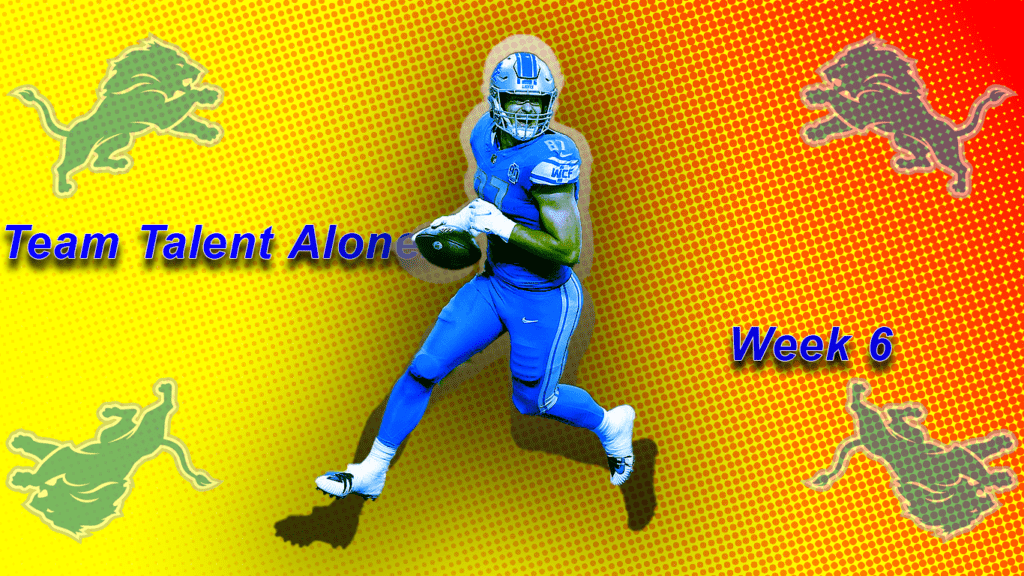Team Talent Alone: Week 6 – Legit LaPorta and Safeties by the Numbers

Film Review: Sam LaPorta – Doing the Dirty Work
We all know the story of the receiving stats of Sam LaPorta so far in his rookie season. Here is his pace for a 17-game season:
- 920.33 Yards
- 8.5 Touchdowns
LaPorta is currently playing more than 80% of offensive snaps for the Lions and has entrenched himself as both a passing option and, as we’re talking about today, a high-quality pass and run blocker.
To diverge from the talking point for a second, the adage for why it’s really hard for rookie tight ends is that it is essentially learning two NFL-caliber positions simultaneously. Typically this shows in limited production on passing downs for rookie tight ends because if a tight end can’t block, it kind of gives away the play when he’s on the field. This is a big reason why the all-time record for rookie tight end receiving yards is still Mike Ditka with 1,076 in a 14-game season. When players come in the league they have to learn to block before they can be brought in and not tip the hand of the play.
Okay back to the actual LaPorta of it all.
Sam LaPorta has gotten off to an excellent start as a blocker. In the run game this season, he’s currently the sixth highest-graded TE by PFF grade (66.4), and in the passing game, he’s seventh (77.8) and has only allowed one pressure.
He’s not just blocking well but, so far is that he is seeking out the blocks. Here’s a clip where he initially stays home to help block on a passing set, but decides that once that assignment is done he should still lay a hit.
We’re now to the obligatory “Hey look at how good Ben Johnson is at play design” portion of the article. I’m not going to post 14 clips of just LaPorta blocking so here are two clips where Sammy L. comes in motion to block the edge defender. Now it’s worth noting that, for both of these blocks, there is probably a better player for him to block but that’s the learning curve and he is seeking out blocks.
Hell, here he is going against Brian Burns in a pass-blocking set.
I’m sure at this point you get the idea. What we’re seeing is not just an exceptional young pass catcher at the TE position, but one of those weapons that OCs drool over where you can have him in on all four downs and not tip your hand. Think back to that first clip, LaPorta runs a route and then comes back to block. The defense can’t know what you’re about to run when you can staff on offense with players like that (see: all of the players on San Fransisco).
Sure there are some rough spots to work out in the blocking, but if we’re grading on a rookie curve, he’s doing exceptionally well.
I think we’re going to get a lot of good LaPorta years and if Goff keeps up with his play six weeks into the season, that could be a very good partnership.
But
We, as an unbiased NFL-enjoying audience, should probably enjoy this while it lasts. It’s getting cold in Detroit and Ben Johnson might be somewhere else next season.
By the Numbers: Comparing Safeties
I remember being a kid and looking at my dad and asking him, “What makes a good safety?” and he told me that to be a good safety you have to “be good at stopping the pass and stopping the run.”
So here’s the thing about that description, it didn’t help me understand Safties at all. In my teens, I always thought Safeties were the coolest players on the field. I grew up as a Commanders fan so I had jerseys for Sean Taylor, LaRon Landry, and Ryan Clark. I’ll be honest, I still didn’t totally get what a safety was.
Fast forward to… well this year. My first year really watching game tape. At this point, I get it like 90%. Safeties play all over the formation but at their core, you want a safety that is good at stopping the pass in coverage and coming down to stop the run at the line, I guess I should have just listened to my dad and saved myself some time.
Today, let’s look at the three safeties on Team Talent Alone: Minkah Fitzpatrick, Kamren Curl, and Kyle Hamilton. Let’s look at their physical attributes, draft profile, and utilization and figure out, whether they are good at stopping the pass and stopping the run?
Kamren Curl
6’2”, 198 lbs.
Curl was covered extensively in last week’s Team Talent Alone so if you like what I do here check that out too.
Curl was drafted in the Seventh Round (suck on that Tom Brady) out of Arkansas. Kam Curl fell in the draft due to his size and lack of athleticism. He ran a 4.6 40. Suffice to say he outperformed his draft stock a bit eh?
His draft profile also didn’t project for him to be very good at stepping up to stop the run, which is due to his size and speed. Hard to step up and tackle Derrick Henry at the line when you’re smaller and slower than Derrick Henry
So, is he good at stopping the pass?
Well, that’s a little complicated. 11-Year-Old Adam was onto something after all. Curl broke out in 2022 and I looked through a lot of data and I honestly couldn’t find a great statistical reason why this happened. Curl just sort of, got good, at Safety. Curl’s coverage grade jumped to 80.8 per PFF. Prior to that, he was still surprisingly good for a seventh-round pick. In his first two seasons, Kamren sported a 65.5 and 69.5 respectively. This year he’s off to a somewhat slower start than past years but that can be partially due to the Commander’s defense having to find ways to cover for the now benched first-round pick, Emmanuel Forbes Jr. This past week against Atlanta, notably the first game of the season with Danny Johnson starting over Forbes, Curl posted his second-highest coverage grade and only allowed 3 receptions on 7 targets.
Is he good at stopping the run?
This is a pretty emphatic yes*. You might notice the little asterisk there and that is because this year has been his worst year in run defense. Now either part of the cause of his decline in stopping the run has been the whole team has been pretty bad against the run (or perhaps part of the team’s decline in run defense has been Kam Curl’s decline in stopping the run). They rank 22nd in EPA/play against the run, 23rd in rushing yards allowed per game and they’ve allowed at least 100 yards every week since Week 2. But we’re off-topic now, this is supposed to be about Kameron Curl. Curl’s decline in rush defense overlaps with two very important stats that will be worth monitoring, an uptick in snaps played in the box (2020-2022: 40.1% 2023: 45.9%) and an uptick in snaps per game (2022: 42.8 2023: 69). Some of this could be chalked up to early season noise. We are only six weeks into a long, grueling NFL season and we’re just now entering the cold weather months that favor defense. Prior to this year, Curl was an elite safety in run defense, posting an 80.5 and 75.6 grade the last two seasons respectively. This year he hasn’t hit his groove yet and is being asked to play differently as they load him up in the box and use him as a linebacker more and more often.
Kyle Hamilton
6’4” 220 lbs
I’m sure that Talent Alone’s own Mike Regan has skipped every other section to look at what I have to say about Kyle Hamilton first.
Hamilton is a sophomore player out of Notre Dame and a former First round pick, largely considered to have been one of the best players in that draft at the time. Hamilton, unlike Curl, is big. I mean like real big. 6’4”, 220 lbs at safety.
Coming out of college, he was recognized for his versatility, competitiveness, and massive frame. These are the same three things I am routinely noticed for
.Hamilton gets the prototypical safety treatment. He plays pretty equally all over the secondary between slot (31.5% of snaps this year) free safety (35.4% of snaps this year) and in the box (26.9% of snaps this year). Side note, having Patrick Queen, Roquon Smith, and Kyle Hamilton all on the field at once is outrageous.
So, Is he good at stopping the pass?
Hamilton had a very up-and-down rookie year as a combination of experimenting with alignment and injury led him to play out of position a lot (especially at slot corner). He’s been much more consistent this year now that they’ve moved him back to the position he was drafted to play.
This year, Hamilton has played 238 coverage snaps and has held up really well. He has yet to allow a touchdown, has an interception, hasn’t allowed more than 50 yards in coverage in a single game, and has a 75.7 coverage grade on the season (slightly down from an 83 in his rookie year).
A big concern with the 2023 Ravens has been their cornerbacks. In fact, it seemed to be by far the weakest position group on that side of the ball. Due to that, the assumption was that teams would throw on them. This was only made worse by an injury to Marlon Humphries right before Week 1 that kept him out until the Pittsburgh game. However, the passing defense has held up surprisingly well, allowing the second-fewest passing yards per game.
Okay sorry for getting bogged down talking about the situation, back to Kyle Hamilton.
Hamilton was ejected in Week 6 against Tenessee due to a helmet-to-helmet hit he laid on Chris Moore that he probably doesn’t feel bad enough about. So his sample size in coverage is lower than Curl’s, but outside of that game he’s been elite in coverage with his lowest grade coming in Week 2 against Cincinnati when he got burned on a catch-and-run by Joe Mixon for 32 yards.
Is he good against the run?
Tackling has been a weak spot for the Notre Dame product in 2023 where he’s already almost tied to his missed tackle total from all of last year (2023:6 2022:7). As an inverse to his stats listed above, part of this can also be due to playing more snaps in the box and less in the slot. Now the guys he is trying to tackle are less Jahan Dotson and more Derrick Henry.
The stats do tell a story of the Raven’s trepidation with relying on Hamilton in the run game. In 2022, when as mentioned above, they moved him mainly into the slot, this correlated to Hamilton’s biggest improvement in rush defense. On top of that, all of last year, Hamilton only played 159 snaps of run defense and in 2023 he’s already up to 131 and is sporting a pitiful 48.8 grade in run defense.
Minkah Fitzpatrick
6’1” 207 lbs
Minkah has the highest draft pedigree of any of the safeties on this list today by a whopping 3 spots over Hamilton (crazy that this article contains an average draft round of round 3).
Fitzpatrick was drafted in 2018 by the Dolphins and traded to Pittsburgh in 2020. In his time at Pittsburgh, Fitzpatrick has routinely been lauded as one of the best safeties in the game and has earned 3 All-Pro bids.
Minkah Fitzpatrick became the center point of the defense as they passed into the current era. Now, supported by elite defensive players like TJ Watt and Cam Heyward and new addition Joey Porter Jr., this defense has become pretty damn stout.
Fitz, unlike the other two guys on the list, is the most “Free-Safety” of the bunch with 45.9% of his snaps coming from the Free Safety spot. Due to this distinguishing feature of his profile, his coverage stats can get a little wonky compared to the other safeties we talked about above.
So, is he good at stopping the pass?
Fitz is arguably a little overrated in the category but that doesn’t mean he’s a slouch. Counting stats-wise, Minkah has been top three in interceptions for safeties three times in his career. Fitzpatrick’s career passer rating allowed a 61.3, which makes them the worst QB in the league by passer rating, anyone who throws the ball toward Fitzpatrick.
It’s worth noting that it’s been a bad stretch at the time of this post for Minkah in coverage. We’re coming off back-to-back weeks where he’s graded below a 60 per PFF against Houston (Stroud Crowd baby) and Baltimore. However, outside of the last two weeks, he’s played at relatively his normal level for coverage, allowing seven yards per reception and zero touchdowns.
Is he good at stopping the run?
Minkah Fitzpatrick is elite at stopping the run. Since 2019, PFF has graded Fitzpatrick in the top 10 in rush defense amongst safeties every year, and based on my half-assed internet research on this, he is the only player who has accomplished this.
The Steelers rarely use their safeties in pass-rush situations, so just about any time Fitzpatrick lines up in the box or on the line he is prone to come in as a run-stopper. To answer the thesis question of this section, Fitzpatrick is very good at stopping the run and there just isn’t much more to say about it.




